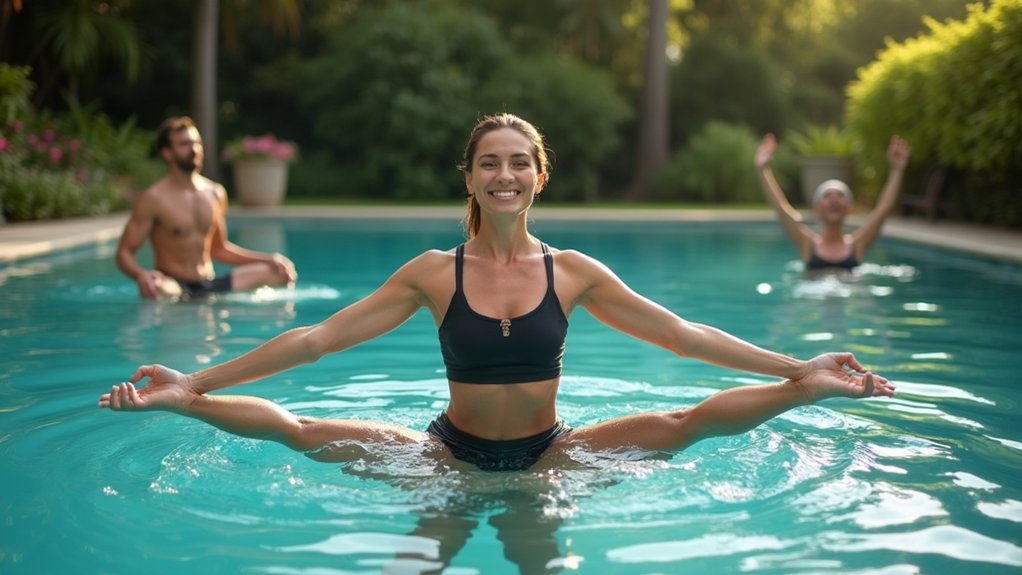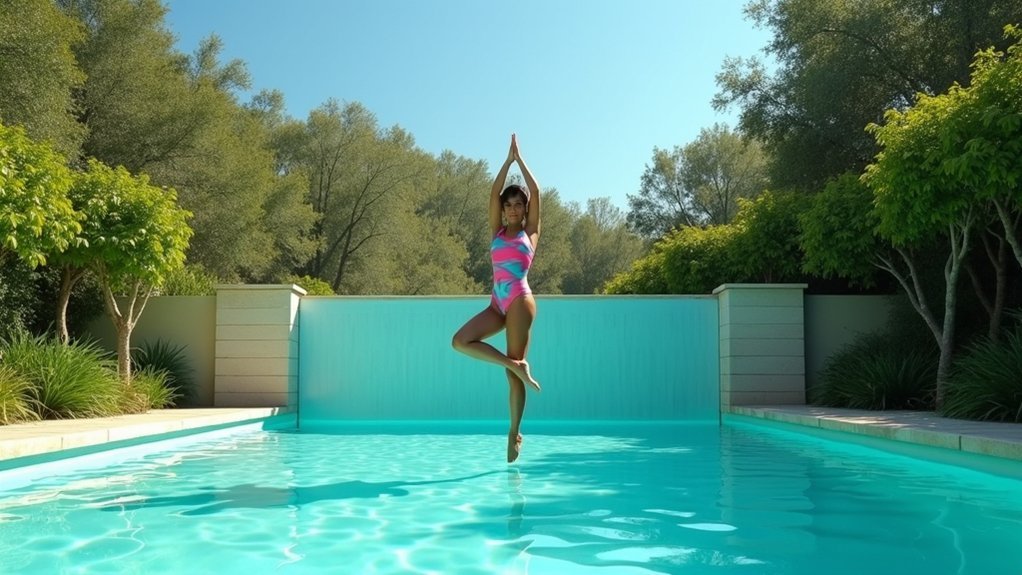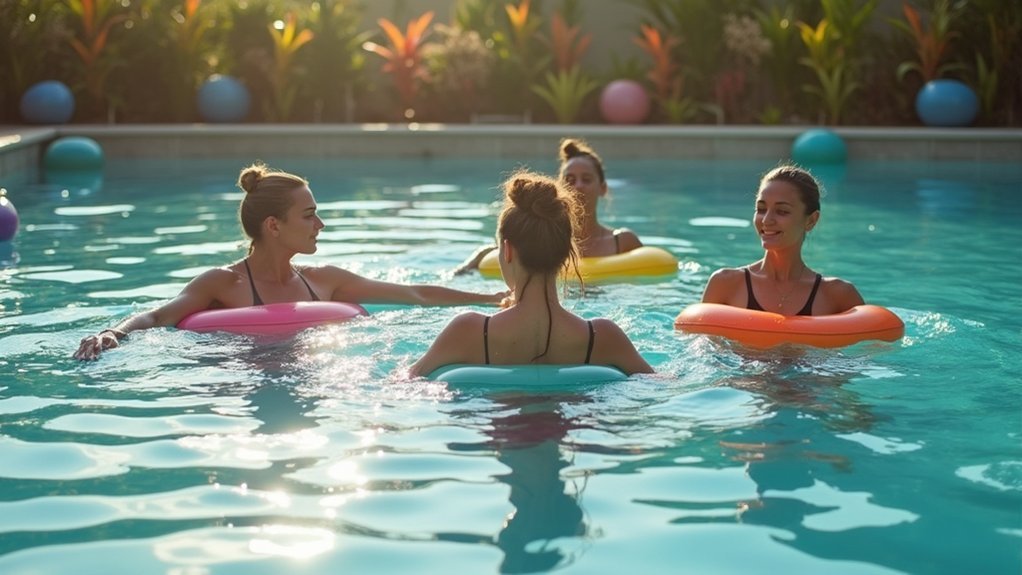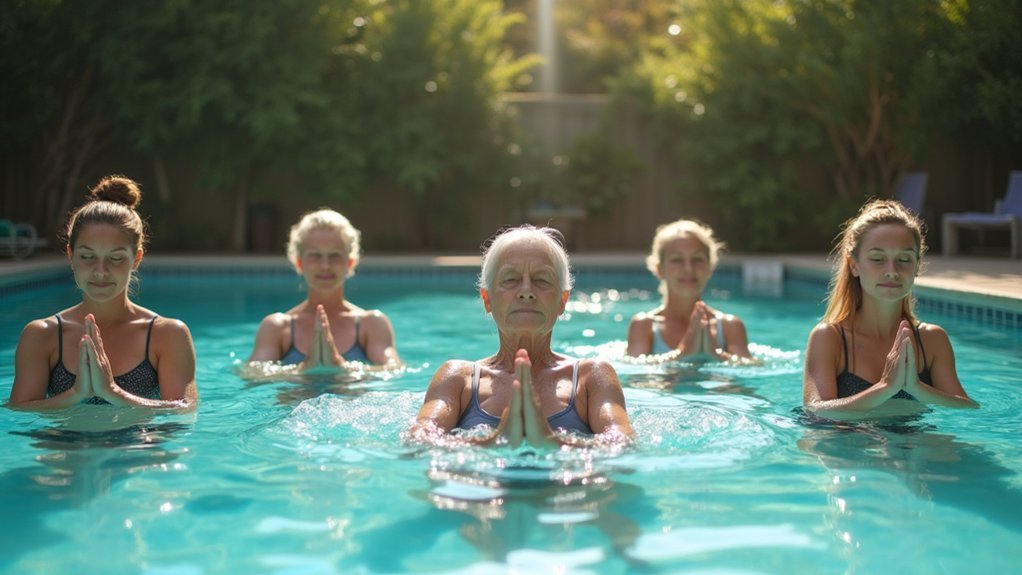Aqua yoga offers gentle, joint-friendly exercises perfect for limited mobility. Try Mountain Pose Namaste for balanced core engagement, Modified Tree Pose with wall support for stability, and Floating Boat using noodle assistance for strengthening. You’ll also benefit from Chair Pose in waist-deep water and gentle Warrior variations with buoyancy support. The water’s resistance strengthens muscles while its buoyancy protects vulnerable joints—discover how these five poses can transform your mobility journey.
Understanding the Benefits of Water-Based Yoga for Joint Health

When you immerse yourself in water for yoga practice, your body experiences immediate relief from gravity’s constant pull. The natural buoyancy supports your joints, reducing pressure that typically affects those with arthritis or limited mobility.
Water’s unique properties transform traditional yoga into a gentler experience. You’ll notice the resistance helps strengthen muscles without stressing vulnerable joints, making aqua yoga ideal if you’re recovering from injuries. The supportive environment allows for deeper stretches and improved flexibility that might be painful on land.
Beyond physical benefits, you’re getting cardiovascular improvements through flowing movements and breathing exercises. The peaceful water setting promotes mental relaxation and stress reduction, enhancing the therapeutic effects of your practice. Aqua yoga is particularly beneficial for older adults as it helps improve balance while providing a safe exercise environment.
This combination of physical relief and mental calm makes aqua yoga particularly effective for joint health.
Mountain Pose Namaste: Finding Balance in the Water
How does Mountain Pose transform when practiced in water? Known as Pranamasana in Sanskrit, this foundational pose becomes gentler yet more dynamic in an aquatic environment. The water’s buoyancy reduces pressure on your joints while providing natural resistance to strengthen your muscles.
Water transforms Mountain Pose into a buoyant sanctuary where gentleness meets strength, creating a dynamic foundation for aquatic practice.
For those with mobility limitations, Mountain Pose Namaste offers a perfect entry point into aqua yoga.
- Use the pool wall for support while finding your balance in hip-width stance
- Engage your core muscles as you bring palms together at heart center
- Practice ujjayi breathing to deepen mind-body awareness
- Allow the water’s natural movement to help you find subtle adjustments in your posture
This pose naturally activates the Heart Chakra (Anahata) when performed with hands in Anjali Mudra at your chest. This pose naturally aligns with the air element, promoting both stability and tranquility while accommodating diverse mobility needs.
Modified Tree Pose With Pool Wall Support

Tree Pose, or Vrikshasana, takes on new dimensions in water, offering balance and stability benefits that complement our previous Mountain Pose practice.
You’ll find this adaptation particularly accessible if you have mobility challenges. Position yourself near the pool wall, using it for support as you shift your weight to one leg.
Place your other foot against your inner thigh or calf (never on the knee). The water’s buoyancy reduces joint pressure while still engaging your core muscles.
Focus on a fixed point to enhance concentration while practicing slow, deep breathing. This practice improves overall balance and coordination as you work to maintain stability in the water environment. If you need additional support, try incorporating a pool noodle under your raised foot.
Remember to work within your comfort level and consider any pre-existing injuries. The resistance of water naturally enhances your balance training while providing a gentle environment for stretching tight hips.
Floating Boat Pose Using Noodle Assistance
Floating Boat Pose offers three key advantages for practitioners with limited mobility: core strengthening, improved balance, and gentle hip flexibility—all without stressing your joints.
By using pool noodles for support, you’ll maintain stability while the water’s buoyancy creates a safe environment for exploring this beneficial pose. The buoyancy of water minimizes the risk of falls during practice while allowing your body to move more freely than on land.
- Position one noodle under your knees and another behind your upper back to create a supportive cradle
- Engage your core muscles while slowly extending your legs, keeping your feet at the water’s surface
- Focus on deep breathing as you hold the pose, allowing the water to assist your balance
- If needed, keep your knees bent or use the pool wall for additional support until you build confidence
Essential Safety Considerations for Aquatic Practice

Safety must come first when practicing aqua yoga, especially for those with mobility limitations or health conditions. Before beginning, consult your healthcare provider and choose a pool with appropriate depth where you can stand comfortably.
Always wear proper attire including water shoes for stability, and stay hydrated throughout your practice. Verify the water temperature is between 78-82°F for ideal comfort and safety.
Use supportive equipment like pool noodles and flotation devices to maintain balance and reduce strain. Don’t practice if you have open wounds, infections, or fear of water.
Take breaks when feeling fatigued or dizzy.
For beginners, start with professional instruction in small classes where instructors can provide personalized guidance and adjustments for your specific mobility needs. Individuals with uncontrolled high blood pressure or heart conditions should seek medical clearance before participating in aqua yoga sessions.
Frequently Asked Questions
How Deep Should the Water Be for Aqua Yoga Practice?
You’ll want water between your belly button and chest for aqua yoga. This depth provides ideal support while maintaining control. Chest-level depth works best for most exercises, but you can adjust based on specific poses.
Can I Practice Aqua Yoga if I Can’t Swim?
Yes, you can practice aqua yoga without swimming skills. Stay in shallow water where you can touch the bottom, use flotation devices for support, and always participate in instructor-led classes for proper safety supervision.
What Water Temperature Is Ideal for Therapeutic Aqua Yoga?
For therapeutic aqua yoga, you’ll find 88-96°F ideal, with 93°F being thermoneutral. If you’re in a mixed class, 88°F works well, while therapeutic pools typically maintain 90-94°F for maximum health benefits.
How Do Waterproof Hearing Aids Perform During Aqua Yoga Sessions?
Waterproof hearing aids perform excellently during aqua yoga sessions. You’ll experience clear sound quality with IP68-rated devices. They’ll resist moisture damage, but you should still follow manufacturer guidelines and dry them thoroughly afterward.
Are There Specific Breathing Techniques Unique to Aqua Yoga?
Yes, aqua yoga features unique breathing techniques where you’ll synchronize breath with buoyancy—exhaling as you sink deeper and inhaling as you rise. You’ll also practice slower breathing patterns that work with water’s natural resistance.
In Summary
You’ve now discovered how aqua yoga can transform your fitness journey despite mobility challenges. The water’s buoyancy creates a gentle, supportive environment where you’ll feel weightless yet strengthened. Don’t let joint pain limit your practice – simply adapt these poses to your comfort level. Remember to prioritize safety, move slowly, and listen to your body. You’ll find new freedom in movement that’s both therapeutic and enjoyable.





Leave a Reply